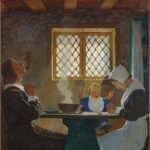
Andrew Wyeth (1917–2009) was an American realist painter, closely associated with the regionalist style, who is perhaps best known for his detailed yet spare depictions of rural American life, particularly in and around his hometown of Chadds Ford, Pennsylvania, and his summer home in Cushing, Maine. Wyeth’s work is characterized by its emotional depth, subdued color palette, and meticulous attention to detail, elements that combine to create a unique sense of realism imbued with a layer of mystery or melancholy.
Born into a family deeply involved in the arts—his father, N.C. Wyeth, was a prominent illustrator—Andrew was trained in art from an early age, largely by his father. This early education not only honed his technical skills but also instilled in him a love for rural landscapes and an appreciation for the narrative potential of everyday scenes and subjects. Despite this, Wyeth’s style diverged significantly from his father’s more colorful and romanticized illustrations. Instead, Andrew pursued a more austere and introspective direction in his art, focusing on the people and places he knew best.
Solitude & Resilience
One of Wyeth’s most famous works, “Christina’s World” (1948), encapsulates many of the qualities that define his oeuvre. The painting depicts Christina Olson, a neighbor in Maine, who, due to a degenerative muscular disorder, is seen dragging herself across a barren field toward a distant farmhouse. The work is notable for its stark realism, emotional resonance, and the haunting, almost eerie, sense of isolation that pervades the scene. Through works like this, Wyeth explored themes of solitude, resilience, and the passage of time, often imbuing his landscapes and portraits with a deeply personal, almost autobiographical, intensity.
Wyeth’s commitment to realism and his focus on rural America at a time when many of his contemporaries were embracing abstraction or urban subjects set him apart in the mid-20th-century art world. Despite this, or perhaps because of it, his work struck a chord with the public, earning him widespread acclaim and popularity, even as critics sometimes dismissed his work as sentimental or outdated.
Throughout his career, Wyeth worked primarily in watercolor and tempera, mediums that allowed him to achieve the high degree of precision and subtlety that characterizes his paintings. His meticulous technique, which involved painstakingly building up layers of color to achieve depth and luminosity, contributed to the distinctive, almost hyper-real quality of his work.
Deep Connections
Wyeth’s art was deeply influenced by his personal connections to his subjects, often featuring friends, family, and neighbors, and the landscapes they inhabited. This personal dimension adds a layer of intimacy to his paintings, inviting viewers into a world that, while often stark and unadorned, is also rich with meaning and emotion.
In addition to “Christina’s World,” Wyeth produced an extensive body of work that includes several other notable paintings, such as “Winter 1946,” “Braids,” and “Trodden Weed,” as well as the somewhat controversial “Helga” series, which revealed a more sensual and intimate aspect of his work. Throughout, his art remained rooted in a deep sense of place and a profound connection to the land and its people.
Andrew Wyeth’s legacy is that of an artist who, through his focus on the ordinary and the overlooked, revealed the extraordinary depth and complexity of the American landscape and character. His work invites viewers to look closer, to see beyond the surface, and to find beauty and meaning in the simplicity of daily life. As such, Wyeth remains one of the most beloved and respected American artists of the 20th century, celebrated for his contributions to the tradition of American realism.




